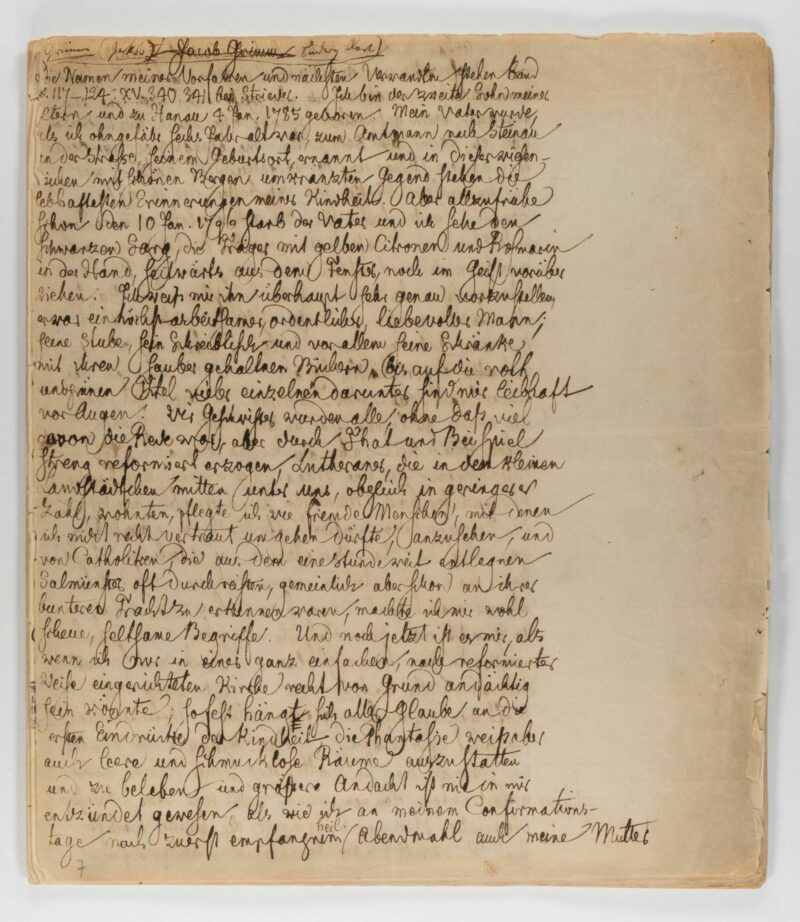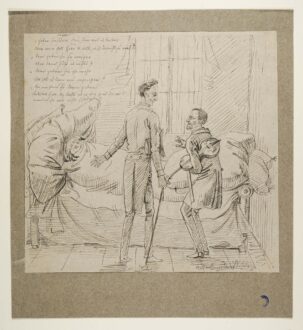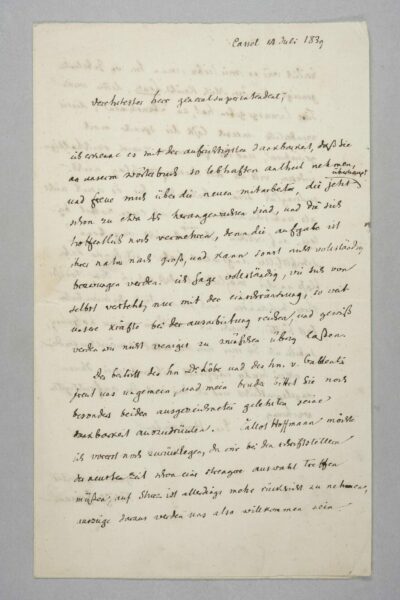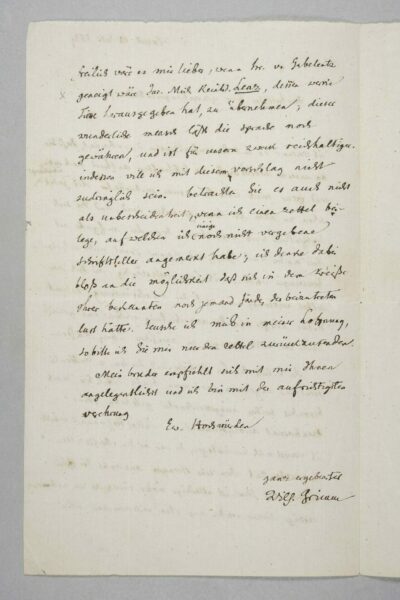© Grimm-Sammlung der Stadt Kassel, Autogr_0288_01_N
Jacob and Wilhelm Grimm lived and worked in Kassel for about 30 years. They left the city a rich and diverse legacy, which is particularly curated and preserved in the City of Kassel Grimm Collection.
Kassel is intimately connected with the Brothers Grimm: the city is the capital of the German Fairy Tale Route, home to the Brothers’ personal copies of the “Children’s and Household Tales”, which have been declared a UNESCO “Memory of the World”, and seat of the internationally renowned GRIMMWELT exhibition. Jacob and Wilhelm Grimm lived and worked in Kassel for about 30 years; according to Jacob Grimm, this was “the most industrious and perhaps the most fruitful time” of their lives. Not only the “Children’s and Household Tales” were created in Kassel, but also other major works such as the “German Sagas” or Jacob Grimm’s “German Grammar” – and even the decision to embark on the “German Dictionary” was made in Kassel.
The significance of the Brothers Grimm for city is also evident from the comprehensive City of Kassel Grimm Collection, which contains and preserves a wide variety of objects connected with the life and work of the Brothers and their fairy tales.
The Grimm Collection currently contains more than 20 groups of items. As well as books, letters and household items from the Grimm family home, it includes drawings, graphics, silhouettes, sculptures and paintings. For instance, one of the main subjects of the graphics are works by their brother Ludwig Emil Grimm, as well as historical and contemporary fairy tale illustrations.
Interesting objects are continuously being added to the collection to guarantee its relevance and appeal – and reinforce Kassel’s image as the city of the Grimms. This opens up new perspectives for research and generates new impulses for public discussion. Die Grimm Collection is a point of contact for picture or research enquiries, and loans items to the GRIMMWELT Kassel and international museums and art exhibitions for public presentations.
On the basis of plans centring on the GRIMMWELT Kassel, which opened in 2015, the city authorities and the University of Kassel were in an ongoing dialogue about what is known as the “decentralised Grimm concept”. This entails the traditional remit of a museum being shared among the three institutions, each according to its specific competencies, and in close collaboration with each other.
One visible result of the cooperation with the library of the University of Kassel is the digital provision of the most valuable items in the Kassel collection in the Grimm Portal, along with other historical Grimm literary treasures. The Portal already contains more than 2,500 letters and over 500 Grimm manuscripts and other documents, including visiting cards, pictures and essays, not to mention the Brothers Grimm’s personal copies of the “Children’s and Household Tales” with their handwritten notes and comments, which are part of UNESCO’s Memory of the World.
© Grimm-Sammlung der Stadt Kassel, Hz_1526 | Konzertmeister Wiele mit seinem Hausarzt | Illustration: Ludwig Emil Grimm
The pen-and-ink drawing is by Ludwig Emil Grimm, Jacob and Wilhelm Grimm’s youngest brother. He worked as a painter, draughtsman and etcher, and was a professor at the Kassel Arts Academy from 1832 onwards. The “painter brother”, as he is often called, documented the life and work of the famous linguists and collectors of fairy tales, and the rest of the Grimm family, in a variety of ways. Many of his works can be found in the City of Kassel’s Grimm Collection. The drawing shown here shows concert master Adolf Wiele in a dialogue with his GP Dr. Wehr at his wife Friederike’s sickbed. Wiele, with his violin tucked under his arm and in a hunched-over position, is speaking urgently to the doctor. The drawing records the bizarre conversation about the right dose of medicine:
“Give your wife some of this, it will make her better
But good heavens, doctor, surely that’s too much?
Then give her less
But then it won’t do any good?
Well, give her more, then…”
Wiele was a well-known character in Kassel – a violinist in the orchestra at the Electoral Theatre and subsequently its concert master – and a relative of Ludwig Emil Grimm. Wiele’s first wife, who died young, was Johanna Böttner, a younger sister of Ludwig Emil Grimm’s wife Marie Böttner, so the two men were brothers-in-law. Even if Ludwig Emil Grimm is unlikely to have actually been present at this scene, he knows the characters well, and this humorous sketch is probably a record of the anecdote as he heard it told.
© Grimm-Sammlung der Stadt Kassel, Autogr_1136 | Brief von Wilhelm Grimm vermutlich an den Theologen Friedrich Hesekiel. 14. Juli 1839
© Grimm-Sammlung der Stadt Kassel, Autogr_1136 | Brief von Wilhelm Grimm vermutlich an den Theologen Friedrich Hesekiel. 14. Juli 1839
The two-page letter was written in Kassel by Wilhelm Grimm on 14. July 1839, presumably addressed to theologian and General Superintendent Friedrich Hesekiel. He thanks the churchman for his collaboration on the “German Dictionary” and names other contributors who were also recruited to work on it.
The letter, which was written a year after work on the “German Dictionary” had begun, underlines the sheer size of the dictionary project; Wilhelm Grimm mentions about 45 assistants and contributors, expressing the hope that “hopefully they will multiply” and explicitly asking the recipient of the letter to sound out his friends and relations as potential contributors. For Wilhelm Grimm is in no doubt: “the task is large by its very nature and cannot otherwise be completely overcome.” Just how large the task really was becomes especially clear in retrospect. The first volume of the “German Dictionary” did not appear until 15 years later, in 1854 – and the 32nd and last volume was not published until 1961, 102 years after Wilhelm Grimm’s death.
You can reach the City of Kassel Grimm Collection by email at:



